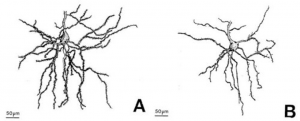Three Definitions of ‘Neuroplasticity’
Introduction
Objective: The objective of this assignment is to familiarize ourselves with the roles of definitions in professional writing, as well as catering the level of technicality of the definitions to the intended audiences.
Criteria: The criteria for the assignment is to define a relatively complex term within our disciplines in 3 forms: parenthetical, sentence, and expanded. These definitions have to take into account a chosen situation and a non-technical audience.
Term, Situation, and Audience
Term: Neuroplasticity
Situation and Audience: A student studying neuroplasticity explaining the term to a group of people who have no prior background in neuroscience, human physiology, and any related sciences that utilize the term. The audience is assumed to know basic high-school level science (i.e. understand that neural means relating to the brain and nervous system).
Definitions
Parenthetical: The study of neuroplasticity (the brain’s ability to change its connections) may lead to possible therapies for memory loss at old age.
Sentence: Neuroplasticity is the brain’s ability to change its structure and connections in response to internal or external stimuli. It is characterized by the physical change of connections within the brain from one area to another to strengthen the processes of the brain or removing neural connections if you no longer need the skill or memory.
Expanded:
How did the term “Neuroplasticity” originate?
Neuroplasticity is derived from the words neuro, which means relating to the nervous system (including the brain), and plasticity, which means the ability of a structure to change as a result of external stimuli. Neuroplasticity is also termed brain plasticity or brain malleability.
How did the term “Neuroplasticity” develop?
People used to believe that the brain stopped developing after childhood. In the mid-20th century, multiple researchers demonstrated evidence that the brain still undergoes changes in adulthood as a result of engaging in new experiences. Consequently, the term ‘neuroplasticity’ became popularized.
What is Neuroplasticity?
Neuroplasticity refers to the brain’s ability to change its structure and connections in response to external stimuli. Some examples of these stimuli are: development from a young age, changes in one’s physical environment, learning new skills, physical and mental training, and injury of the brain or a body part. Neuroplasticity is largely characterized by structural and functional changes in the brain’s neurons (nerve cells in the brain that receives and sends information to different brain regions). These changes can be either the strengthening of connections and speed of information transfer of neurons due to brain stimulation, or the removal of certain connections and reduction of speed of information transfer due to lack of stimulation to the brain. These changes can also be seen during development of a child to an adult as well as when there is injury to the brain or body parts (i.e. when one part of the brain is removed due to a brain tumor).
What are the mechanisms of Neuroplasticity?
Neuroplasticity can come in the form of strengthening the brain’s nerve connections or weakening these connections. Any change to the brain (increasing or decreasing connections) can be characterized as neuroplasticity.
Strengthening the brain’s nerve connections happens through repeated experiences, such as learning or practicing a skill. In the brain, this can be characterized as nerves forming new branches to reinforce its connection to other nerves or brain regions. Another way strengthening of connections can happen is when nerves make new connections, which happens every time you practice a skill. So, the more something is experienced, neuroplasticity will occur in the form of strengthening the connections in the brain.
Weakening the brain’s nerve connections happens through injury to the brain or other body parts. The lack of practice or experience in a skill or other activity can also weaken connections. In the brain, this can be seen as the removal of these nerve connections. This process is stimulated when the particular experience occurs or the decrease of nerve branches.
What are some examples of Neuroplasticity?
Learning how to play the piano leads to neuroplasticity. When you continuously practice the piano, your brain is changing by strengthening the nerve connections between your hands playing the notes and your ears listening to the notes. For instance, when you press a note and hear a sound that you expected, this will register in your brain and the nerve connections that make this happen will strengthen. These connections between your hands and ears are located somewhere in your brain, where the strengthening of nerve connections take place.
Stopping your regular piano practice also leads to neuroplasticity. When you have been practicing the piano, you have these strong connections. But when you stop playing regularly, you start to forget how to play or “get rusty”. This is because the connections in your brain that connect what you hear to the movements of your finger are being removed due to the lack of practice and stimulation of the brain in this capacity.
Figure 1: A close-up of neuron branches in the human brain

Figure 1 is one example of what a neuron in the brain looks like when neuroplasticity occurs. Strengthening of neuron connections is shown from picture B to A, when the neurons grow more branches as a result of stimulation (i.e. learning how to play the piano). Weakening of neuron connections is shown from picture A to B, when neuron branches decrease due to lack of stimulation to that particular area of the brain (i.e. stopping regular piano practice).
References
[Illustration of synaptic pruning]. (n.d.) https://mokaspetridish.files.wordpress.com/2010/01/pruned.jpg
Hoiland, E. (n.d.). Brain Plasticity: What is it?. Neuroscience for Kids. Retrieved September 29, 2020 from https://faculty.washington.edu/chudler/plast.html
Neuroplasticity. (2020, August 17). Physiopedia. Retrieved September 29, 2020 from https://www.physio-pedia.com/index.php?title=Neuroplasticity&oldid=246064.
William, M. (2017, January 24). Definition of Neuroplasticity. Retrieved September 29, from https://www.medicinenet.com/script/main/art.asp?articlekey=40362
Leave a Reply